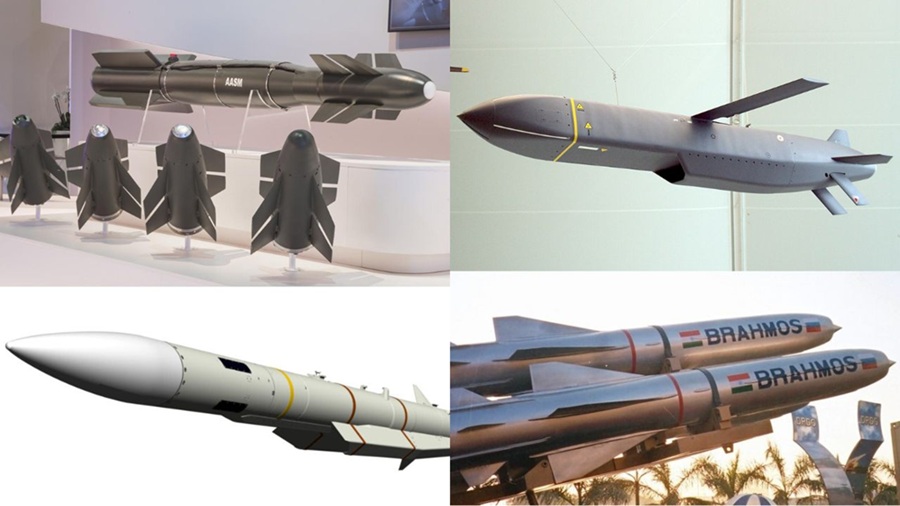India’s defense landscape has evolved significantly over the last few decades, with the development and procurement of a wide range of advanced missile systems. From supersonic cruise missiles to air-to-air and air-to-surface precision-guided munitions, India’s missile arsenal is central to its deterrence posture and combat capabilities. However, behind each launch and test is a hefty price tag. In this post, we take a look at some of the key missiles used by India—BrahMos, SCALP, ASTRA, AASM Hammer, and Akash—and explore their capabilities along with the cost of wielding such cutting-edge weaponry.
1. BrahMos – The Supersonic Precision Beast
Type: Supersonic Cruise Missile Origin: Joint venture between India (DRDO) and Russia (NPOM) Range: 450–500 km (extended versions in testing) Speed: Mach 2.8–3.0 Launch Platforms: Land, sea, air (Su-30MKI), submarine (in trials) Cost: Approx. ₹30–35 crore ($3.5–4.2 million) per unit
The BrahMos missile is widely regarded as one of the fastest cruise missiles in operation. Designed for precision strikes against high-value targets, it has become a cornerstone of India’s deterrent capability. Its versatility across multiple platforms gives it an operational edge, allowing rapid deployment from sea, land, and air.
BrahMos is especially significant in maritime strike roles and has been integrated into Indian Navy warships and the Indian Air Force’s Su-30MKI fighters. The air-launched version, BrahMos-A, is modified for reduced weight and enhanced aerodynamics.
Its high cost is attributed to its advanced guidance systems, high-speed propulsion, and precision strike capabilities. However, its deterrent value arguably outweighs the expense.
2. SCALP (Storm Shadow) – Deep Strike from the Rafale
Type: Long-Range Air-Launched Cruise Missile Origin: France (MBDA) Range: 560 km+ Speed: Subsonic Launch Platform: Dassault Rafale Cost: Approx. ₹20–22 crore ($2.4–2.7 million) per unit
The SCALP EG (Système de Croisière Autonome à Longue Portée – Emploi Général) missile, known as Storm Shadow in UK service, was acquired as part of the Rafale deal with France. It enables the Indian Air Force to conduct deep-strike missions well beyond enemy air defense zones.
Fitted with a BROACH warhead, SCALP is capable of penetrating hardened structures such as bunkers and underground command centers. Its stealth design and low radar cross-section make it exceptionally hard to detect.
SCALP’s cost reflects its capability as a strategic strike weapon, giving India long-range precision options without entering hostile airspace—a crucial factor in modern warfare.
3. ASTRA – India’s Homegrown Air-to-Air Answer
Type: Beyond-Visual-Range Air-to-Air Missile (BVRAAM) Origin: India (DRDO) Range: 110 km (Mk-I); 160 km+ (Mk-II in development) Speed: Mach 4.5 Launch Platform: Su-30MKI, Tejas, Mirage-2000 (integration ongoing) Cost: Approx. ₹7–8 crore ($850,000–$1 million) per unit
ASTRA is India’s first indigenous beyond-visual-range air-to-air missile and marks a significant milestone in Indian missile technology. Designed to target high-speed aircraft in both head-on and tail-chase modes, it gives Indian fighter jets a decisive edge in aerial combat.
ASTRA’s cost is considerably lower than imported counterparts like the Meteor missile (estimated at over ₹20 crore), making it a cost-effective solution for equipping a wide range of fighter aircraft.
Ongoing trials of ASTRA Mk-II promise even greater range and accuracy, potentially rivaling some of the best BVRAAMs in the world.
4. AASM Hammer – French Precision for Indian Rafales
Type: Precision-Guided Air-to-Surface Munition Origin: France (Safran Electronics & Defense) Range: 70–80 km Guidance: GPS + Inertial + Laser (optional) Launch Platform: Dassault Rafale Cost: Approx. ₹1–1.5 crore ($120,000–$180,000) per unit
India inducted the AASM Hammer (Highly Agile Modular Munition Extended Range) bombs to equip the Rafales after the 2020 border stand-off with China. These smart munitions provide Rafale jets the capability to hit fortified targets with pinpoint accuracy.
The modular nature of Hammer allows multiple configurations of warhead and guidance kits, making it a flexible and relatively inexpensive option for precision strikes compared to full-scale cruise missiles.
Its quick induction under emergency procurement reflects both the strategic urgency and cost-efficiency of such modular munitions.
5. Akash SAM – Shield of the Skies
Type: Surface-to-Air Missile (SAM) Origin: India (DRDO) Range: 25–30 km (Akash-1), up to 70 km (Akash-NG in development) Speed: Mach 2.5 Launch Platform: Ground-based, mobile launchers Cost: Approx. ₹2.5–3.5 crore ($300,000–$420,000) per missile
The Akash missile system is India’s indigenously developed medium-range SAM designed to counter aerial threats like fighter jets, UAVs, and cruise missiles. It is deployed with both the Indian Army and Air Force.
Akash’s relatively low cost makes it a viable choice for layered air defense networks, especially when compared to international systems like the U.S. Patriot or Israeli Barak-8. The newer Akash-NG promises better performance, mobility, and reaction time.
With proven capability and successful export interest, Akash is not only a cost-effective shield for Indian skies but also a growing player in the global arms market.
Conclusion: Firepower at a Price
India’s missile arsenal is a mix of indigenous innovation and strategic imports. While high-end missiles like BrahMos and SCALP come with significant financial costs, they serve as critical tools of deterrence and defense. On the other hand, indigenous solutions like ASTRA and Akash demonstrate that high performance does not always come with a high price tag.
As India continues to modernize its military, cost-effective, scalable, and locally manufactured missile systems will likely take center stage. Still, when national security is at stake, capability often outweighs cost—and India appears ready to pay the price for peace through preparedness.
